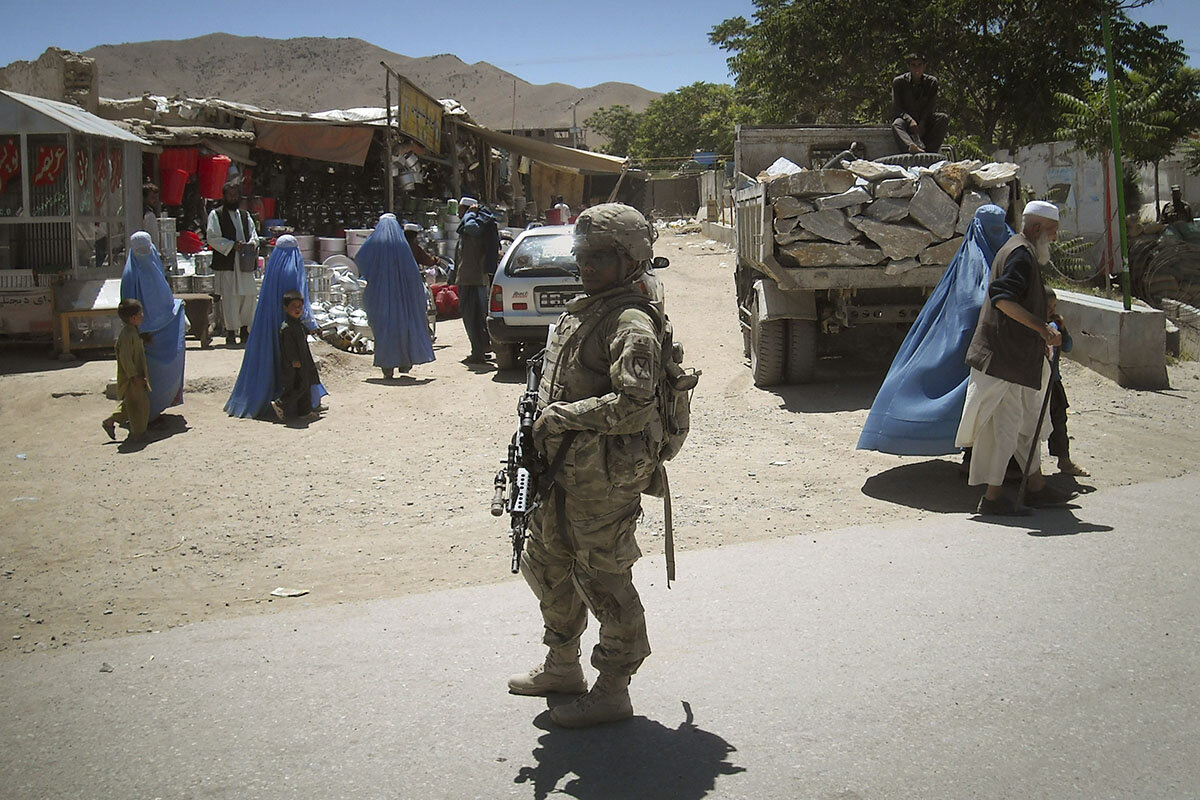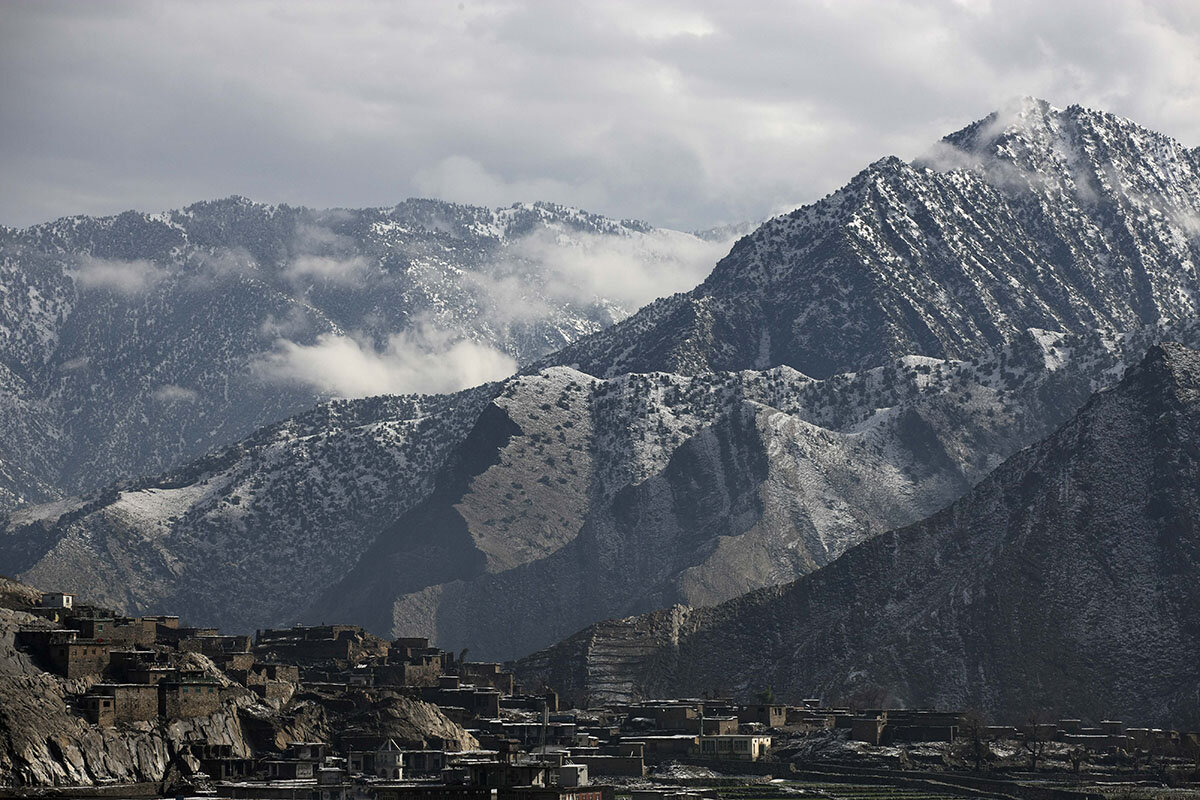Looking back at Afghanistan as the past returns
Loading...
| Sacramento, Calif.
Morning sunlight poured into the third-floor office of Abdul Hakim Mujahid as he stared down at the streets of Kabul. The onetime Taliban ambassador to the United Nations found himself in a reflective mood as he pondered Afghanistan’s future.
“It was wrong for the United States government to collapse the Taliban regime while totally ignoring that you needed the Taliban to be involved in forming policy or you would get this,” he said.
When we met in 2012, Mr. Mujahid belonged to Afghanistan’s High Peace Council, and “this” referred to the long-running stalemate between the U.S. military and the Islamist insurgency.
Why We Wrote This
Monitor correspondent Martin Kuz spent years reporting from Afghanistan for Stars and Stripes. The uncertain future now facing the country was already clear by the war's midpoint, he writes. And his thoughts are with the people he met.
During the past week, as the Taliban seized Kabul and reclaimed the country, his words echoed in my memory, except “this” had gained new meaning: the rapid fall of the Afghan government, the large-scale surrender of its security forces, and a sudden, devastating return to the past. Twenty years erased before the world’s eyes.
My sense of foreboding about such a scenario deepened in the weeks after President Joe Biden announced in April that he would withdraw America’s remaining troops by Sept. 11. The looming conclusion of the country’s longest war would occur with the Taliban’s influence at its highest level since U.S. forces toppled the regime in 2001.
In December that year, Donald Rumsfeld, then the secretary of Defense under President George W. Bush, rejected the Taliban’s offer to surrender. The chances of a peaceful resolution never again appeared so close.
Over the ensuing two decades, with the Afghan government struggling to assert its legitimacy, a saying attributed to Taliban fighters – “You have the watches, we have the time” – evolved from feeble taunt to thorny truth.
In less pithy terms, Mr. Mujahid, who with his dark beard and gold-rimmed glasses resembled a college professor, conveyed the same sentiment – even as the peace council ostensibly sought to end the war.
“In every district of every province, you have a Taliban governor, a military commander, and a judge,” he told me in fluent English. The city’s daily pulse rose with the sun as taxi cabs wove between buses carrying office workers, fruit vendors pushing wooden carts, and boys and girls riding bicycles to school. “People go to the Taliban because it is better known to them than the government.”
Better known and – left unsaid – more feared.
Repeating history
I first arrived in Afghanistan on May 2, 2011, landing in the pre-dawn darkness at Bagram Airfield. Hours later, news broke that U.S. forces had killed Osama bin Laden across the border in Pakistan. His death drew headlines around the world yet represented a false summit. The war had reached only its halfway point.
The number of American troops deployed to the country topped 100,000 that spring, capping a two-year buildup that began soon after President Barack Obama took office in 2009. The men and women in uniform I encountered in the following days and weeks held few illusions that either bin Laden’s death or the troop surge would deter the Taliban.
“The British came here, then the Russians, now us,” said Spc. Joshua Duren as night descended on Logar province, south of Kabul. “You wonder if we’re just repeating history.”
I had joined his Army unit on a five-day mission to “win hearts and minds,” a military phrase recycled from the Vietnam War, and one that retained its hollow resonance. Carrying assault rifles and clad in body armor, the soldiers walked through mud-hut villages, handing out candy and backpacks to children and gathering with tribal elders to encourage them to defy the Taliban.
The unit had come under fire earlier in the day from combatants hidden in the surrounding foothills. A helicopter airlifted two wounded soldiers to safety. In the evening, as his platoon mates prepared to sleep beneath an endless tapestry of stars, Specialist Duren assessed the war with a candor lacking in its architects and commanders.
“You’re basically trying to create a new country in a country that’s been around for centuries,” he said. In the fading light, he looked decades older than his 23 years, aged by the rigors of combat.
“If we’re not planning to stay forever, why do we think Afghans will side with us or the government they know we’re paying for? Whenever we leave, it’s going to fall apart.”
The war’s deep toll
Two months later, I embedded with an Army unit headed into the Pech Valley in Kunar, a province bordering Pakistan and beset by violence. The U.S. military had pulled out of the valley six months earlier, and in the interim, the Taliban had battered Afghan security forces.
Insurgents welcomed back the Americans by downing a Chinook helicopter with a rocket-propelled grenade. Pilot skill and abundant luck spared the lives of the 15 soldiers and crew members on board.
I asked the region’s Afghan commander about the return of U.S. troops. “It is very important to us that we have support until we build our own capabilities,” Rahmdel Haidarzai said. His placid eyes and reserved manner suggested a bank teller more than a man of war. “We want to do this as quickly as we can, but it is something that requires time.”
Ten years after our exchange, almost to the day, Taliban fighters captured the provincial capitals of Kunar and Logar as they swept back into power. The next day they entered Kabul.
The Afghan military offered limited resistance to the Taliban after U.S. troops abandoned Bagram Airfield without warning in early July. A series of negotiated surrenders with Afghan commanders in districts and provinces across the country enabled insurgents to march into the capital last weekend with few shots fired.
The swift collapse provoked criticism from U.S. officials, including President Biden, who in a national address earlier this week described Afghan forces as “not willing to fight for themselves.” He omitted mention of the deep toll of a war that had claimed the lives of 66,000 Afghan military and police personnel, and more than 47,000 civilians.
A final trip to the country in 2016 revealed to me the nearly impossible burden that Afghan soldiers carried. I spent time that summer with an army battalion trapped in a triangle of combat with Taliban and Islamic State fighters in the Hindu Kush mountains near Pakistan.
The pervasive corruption among military and government officials that siphoned away equipment, supplies, fuel, food, and wages from soldiers throughout the country had depleted the morale of the unit’s young men. They told of waiting in vain for resupply shipments during firefights, forcing them to retreat as they ran out of ammunition. They felt exploited, forgotten, expendable.
“It is hard to win a war without bullets,” Muhammad Yousuf said. At age 23, he had given five years of his life to the army, and he had seen too many of his comrades fall to ignore the cruelties of fate. He worried his infant son would grow up fatherless.
“How can we win if we are dying?”
Cast into uncertainty
The question shadowed me when I later visited an Afghan military hospital outside the eastern city of Jalalabad. Dozens of soldiers had switched to a uniform of blue pajamas as they rested in bed to recover from bullet and shrapnel wounds. White bandages swathed arms and legs, hands and feet.
A soldier with casts on his ankle and forearm moaned in his sleep. Another lay on his side in silence, eyes open and unblinking, the top of his head wrapped in gauze. He looked younger than 16, the minimum age to enlist.
The fallout of the war on children drew into sharper focus after I traveled to Kabul to meet with Dr. Habib Rahman at the Indira Gandhi Institute of Child Health. As Afghanistan’s lone pediatric burn surgeon, he treats youngsters from across the country, most of whom are injured in household mishaps involving boiling water or cooking fires. He compared their plight to the nation’s.
“The parents have very little education, and many of the families live in poor conditions,” he said. “This is because of war. We have a bad economy and we don’t have enough schools. Children are unsupervised, and the parents sometimes are too young to know how to raise them. This is how accidents can happen.”
I spoke with Dr. Rahman on a video call earlier this week after the Taliban regained control of the capital. He had waded into the country’s bureaucratic morass in 2018 seeking to obtain visas for him, his wife, and their 10 children to move to the United States.
Their applications stalled as the Trump administration tightened restrictions on immigrant and refugee admissions. Three years later, with Western countries in the midst of a chaotic evacuation effort, the Taliban’s ascendance has cast the doctor and his family into uncertainty alongside tens of millions of Afghans.
“There is very much confusion,” he said, his voice as weary as his expression. He rubbed his eyes beneath his glasses as one of his daughters appeared on the screen, smiling and waving, an innocent oblivious to war. “The most important thing is to make sure the children can be safe,” he said.
Expanded access to education for girls and greater business opportunities for women rank as two of the brightest points of progress in Afghanistan during the past two decades. Rangina Hamidi worked to embody that new entrepreneurial spirit when she returned to her homeland from Virginia in 2003 to promote women’s rights.
Five years later, she founded Kandahar Treasure, a company that employs 350 women who produce embroidered handcrafts. We sat down for tea in Kabul in 2011, three months after the assassination of her father, then the mayor of Kandahar. She recalled her optimism in those first post-Taliban years.
“It was an undeveloped nation: no roads, no electricity, bombed-out buildings,” she said. “Yet there was still this energy of people wanting to do things. Everywhere you looked, people were trying to start a new life.”
Ms. Hamidi absorbed the sadness and disillusionment that followed her father’s murder, and in time, she rose to become the country’s first female education minister. Unlike Afghan President Ashraf Ghani, who fled into exile, she has vowed to stay in Afghanistan. She wants to prevent the Taliban from reversing the advances of the past 20 years.
The United States will watch from afar.








